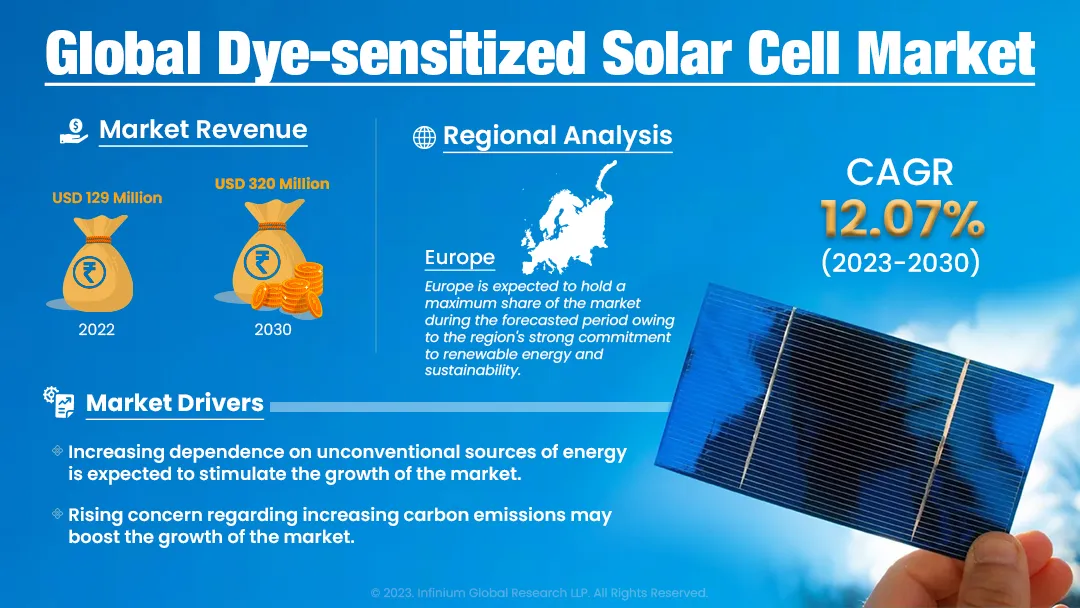Dye-sensitized Solar Cell Market (Type - Natural Dye Sensitizers, and Synthetic Dye Sensitizers; Application - Portable Charging, Building-integrated Photovoltaics [BIPVs], Embedded Electronics, Automotive-integrated Photovoltaics [AIPVs], and Others): Global Industry Analysis, Trends, Size, Share and Forecasts to 2030
A recent report published by Infinium Global Research on dye-sensitized solar cell market provides in-depth analysis of segments and sub-segments in the global as well as regional dye-sensitized solar cell market. The study also highlights the impact of drivers, restraints, and macro indicators on the global and regional dye-sensitized solar cell market over the short term as well as long term. The report is a comprehensive presentation of trends, forecast and dollar values of global dye-sensitized solar cell market.
Market Insight:
A Dye-sensitized Solar Cell (DSSC) is refers to a thin-film solar cell that connected to sunlight for the generation of electricity through an innovative design that consists of a photosensitive dye. DSSC offers a cost-effective and flexible alternative concerning traditional silicon-based solar cells. The principle behind DSSC is in their capacity to convert solar energy into electrical current by utilizing a light-absorbing dye. Light-absorbing dye initiates the electron transfer process and converts solar energy into electrical current. In DSSC there is a semiconductor layer, primarily composed of titanium dioxide nanoparticles. These titanium dioxide nanoparticles serve as the electron transport material. Further, a thin layer of the photosensitive dye synthetic or natural is coated on the semiconductor. The choice of dye is important as it determines the ability of cells to absorb sunlight efficiently. The dye absorbs photons when sunlight strikes the DSSC, it initiates the release of electrons. These electrons move through the semiconductor layer toward the electrodes, generating an electric current. The semiconductor layer is situated between two electrodes, one electrode collects the electrons and transfers them to the external circuit, while the second one completes the circuit. While completing the circuit the second electrode accepts electrons from the external circuit and then the cycle is completed.
The increasing dependence on unconventional sources of energy is the primary driver of the market. As global energy demands continuously increase, there is a rising shift towards non-sustainable energy solutions. This shift is expected to promote the expansion of the market. Additionally, growing concerns related to increasing carbon emissions are propelling the growth of the market. The rising need to mitigate the argumentative effects of climate change has significantly raised the focus on clean and renewable energy sources. Thus, there is a rising demand for technologies that are responsible for the reduction of carbon footprints, boosting market growth. However, the stability issues and low photoelectric conversion efficiency of the cells hampers their widespread adoption, further limiting the market growth. Moreover, technological advancements can present promising growth opportunities for the market. The continuous research and innovation in the dye-sensitized solar cell are expected to lead to market expansion.

The global dye-sensitized solar cell market is segmented into North America, Europe, Asia Pacific, and the rest of the world. Europe is expected to grab a high share of the market during the forecasted period due to the strong commitment of the region to renewable energy and sustainability. The countries in the Europe region are highly adopting and continuously investing in clean energy technologies, to fulfill ambitious climate goals. Europe region consists of robust research and development that works to innovate new technology in solar energy. In addition, the presence of several research institutions and high collaborations between academia and industry named the region as a hub for advancements in dye-sensitized solar cell technology. These innovative approaches contribute to the market's expansion by improving the efficiency, and overall performance of the system. Moreover, the North America region is expected to hold a noteworthy share of the dye-sensitized solar cell market. The growing awareness and commitment for the adoption of renewable energy sources are promoting the growth of the market over the projected period.
Report Scope of the Dye-sensitized Solar Cell Market:
| Report Coverage | Details |
|---|---|
| Market Size in 2022 | USD 129 Million |
| Market Size by 2030 | USD 320 Million |
| Growth Rate from 2023 to 2030 | CAGR of 12.07% |
| Largest Market | Europe |
| No. of Pages | 180 |
| Market Drivers |
|
| Market Segmentation | By Type, and By Application |
| Regional Scope | North America, Europe, Asia Pacific, and RoW |
Segment Covered
The report on global dye-sensitized solar cell market covers segments such as type, and application. On the basis of type, the sub-markets include natural dye sensitizers, and synthetic dye sensitizers. On the basis of application, the sub-markets include portable charging, building-integrated photovoltaics [BIPVs], embedded electronics, automotive-integrated photovoltaics [AIPVs], and others.
Companies Profiled:
The report provides profiles of the companies in the market such as Sharp Corporation, Peccell Technologies, Inc., G24 Power Ltd., Fujikura Ltd., Ricoh Company Ltd., Solaronix SA, Dyenamo AB, Exeger Operations AB, Oxford Photovoltaics, and Nissha Co., Ltd..
Report Highlights:
The report provides deep insights into demand forecasts, market trends, and micro and macro indicators. In addition, this report provides insights into the factors that are driving and restraining the growth in this market. Moreover, The IGR-Growth Matrix analysis given in the report brings an insight into the investment areas that existing or new market players can consider. The report provides insights into the market using analytical tools such as Porter's five forces analysis and DRO analysis of the dye-sensitized solar cell market. Moreover, the study highlights current market trends and provides forecasts from 2023-2030. We also have highlighted future trends in the market that will affect the demand during the forecast period. Moreover, the competitive analysis given in each regional market brings an insight into the market share of the leading players.
Please Choose One of them.